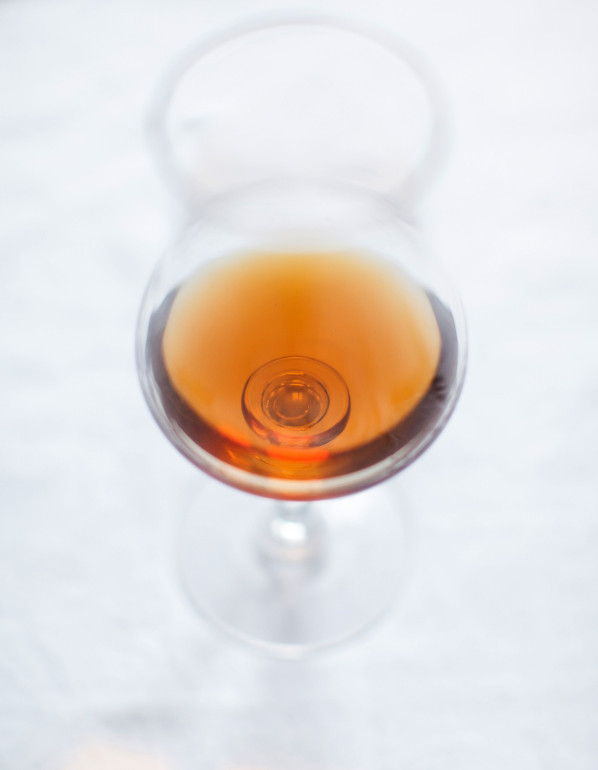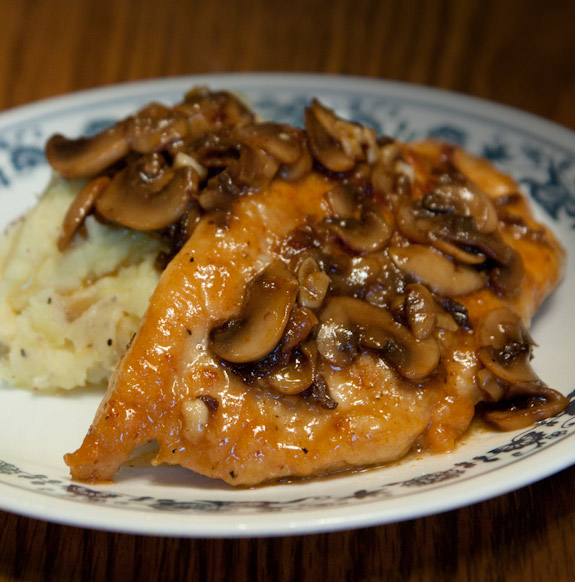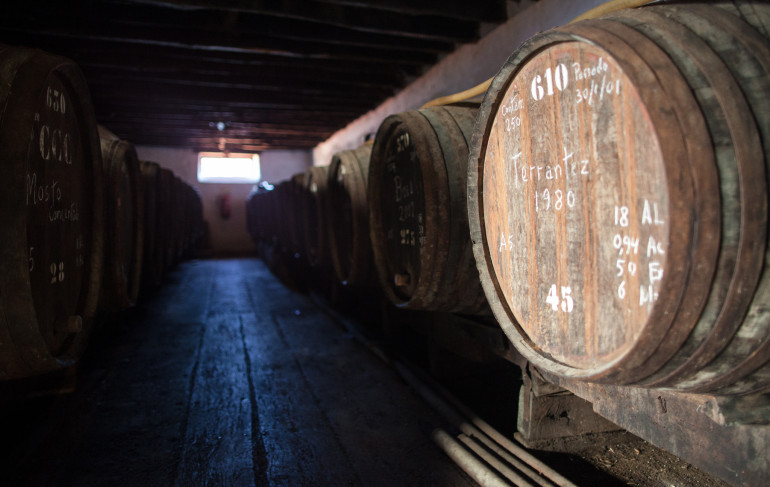Learn about Madeira wine: from how it tastes, to the different styles, and using Madeira in cooking and cocktails.
Madeira is one of the few wines that hasn’t changed since it became popular 300 years ago.
What is Madeira Wine?
Madeira is a fortified wine available in a range of dry to sweet styles. It gets its name from the island of Madeira, a small, beautiful rock in the middle of the Atlantic Ocean. Madeira’s unique taste comes from repeatedly heating the wine. The heating creates a wine with fascinating flavors of roasted nuts, stewed fruit, caramel, and toffee.
The Taste of Madeira: There are several tastes profiles, but most will have flavors of Caramel, Walnut Oil, Peach, Hazelnut, Orange Peel, and Burnt Sugar.
When to Drink Madeira: Dry styles of Madeira (such as Sercial and Verdelho) are served chilled with starter courses, and sweeter styles as after-dinner-sippers like a fine Cognac.
Madeira for Cooking
US law allows bulk-winemakers the ability to use Madeira cooking wines. Warning: these wines are not true Madeira! You can find inexpensive Madeira wine for cooking. Look for Finest or Rainwater on the label. (see more on cooking with Madeira below)
A Wine Born at Sea
During the 1600 and 1700s, wine often spoiled and needed to be fortified (by adding a little brandy) to survive the voyage at sea.
At the time, the island of Madeira was a vital provisioning point for journeys to the Americas and the East Indies and shippers would load up on Madeira wine on their way to England and the Americas. The casks of Madeira wine would be heated and cooled as the ships passed through the tropics. Shippers noticed how the wine’s flavor deepened and became better and called this sea-aging “Vinho da Roda.”

Types of Madeira Wine
Two main types of Madeira have several unique styles ranging in quality:
- Blended Madeira: Inexpensive wines of average quality with a few exceptional aged styles.
- Single-Varietal Madeira: The highest quality Madeira wines made primarily of 4 different varieties.
Blended Madeira
Blended Madeira is often inexpensive, and low-quality, but several higher-end examples make wonderful sipping wines; these usually carry an age designation.
- Finest Madeira isn’t the finest style of Madeira, but instead a 3-Year-Old blended style with the grape Tinta Negra.
- Rainwater Madeira is a fruity blend that must age at least three years before release. This inexpensive style is good for cooking or mixing in cocktails but isn’t half bad raw. Producers use Tinta Negra for rainwater and other young blends.
- Reserve, that oft-abused wine labeling term, has different meanings in Madeira. Reserve wines are between 5-10 years of age, Special Reserve is 10-15 years old and undergoes a higher quality winemaking process, Extra Reserve is 15-20 years in age.
- 20 Year Old is a multi-vintage blend that incorporates wines from several different years proven by a panel to taste at least 20 years old, and often older. 30 Year Old and 40 Year Old Madeira follow this same pattern.
Single-Varietal Madeira
Varietal Madeira represents the highest quality Madeira wine, perfect for aperitifs or dessert wines. These wines are made as both non-vintage blends and single vintage wines that can age for centuries due to Madeira’s unique winemaking process.
- Sercial (“Ser-seal”) is the brightest, crispiest style of Madeira. Often served as an apéritif at the start of the meal, or alongside light fish and vegetable dishes. Sercial shows lemony, spicy, herbaceous notes and often displays a stony mineral character on the palate. These wines have a slight sweetness that is offset by their acidity, especially when served chilled.
- Verdelho (“Ver-dell-oo”) is smokier, slightly more concentrated, and richer than Sercial. A classic pairing for Verdelho Madeira is soup, especially seafood bisque or smoked potato and leek soup. Verdelho’s dryness and intensity of flavor make it one of the most flexible Madeira styles for pairing with foods of varying richness. Verdelho has notes of spice, smoke, and light caramel.
- Boal or Bual (“Buwall”) is a sweet Madeira that shows incredible complexity and aromatic lift. Open a bottle of old Bual in your kitchen, and you might smell it in your dining room a few minutes later. Boal is excellent with desserts that incorporate nuts, figs, stewed fruit, caramel, or chocolate. With aromatic, rich cheeses, Boal is an amazing pairing. Boal smells and tastes like roasted coffee, salted caramel, bitter cacao, dates, and golden raisins.
- Malmsey (“Malm-see”) is the richest and sweetest style of Madeira. You can pair Malmsey with rich chocolate desserts, ice cream, and cheese, or just sit with a glass by the fireside. Malmsey is dessert in and of itself. It’s common for Malmsey to show the most fruity, roasted nut, and chocolate notes of Madeira’s styles. Just like Boal, Malmsey can live for decades and even centuries in some cases.

Extra Rare Styles of Madeira
There are rare varieties on Madeira Island, such as Terrantez and Bastardo. In addition to rare grape varieties, there are also some more rare styles and labeling terms that you may come across while shopping for Madeira:
- Colheita Madeira: like its cousin in the Port trade on mainland Portugal, is a wine from a single vintage. Colheita Madeira must be aged a minimum of five years before release and is considered one of Madeira’s most age-worthy categories.
- Frasqueira Madeira is a rare, high-quality style meant to age for a long time, and must be aged a minimum of twenty years in cask before release.

Cooking with Madeira
The complex, rich and layered character makes it a fine substance for deglazing pans, reducing sauces and adding to salad dressings. It’s so powerfully flavored that you only really need a splash to make a difference.
Mushrooms are one of the greatest partners for Madeira’s sweet earthiness. For this, you sauté mushrooms and splash in Madeira before adding chicken or vegetable stock to make the sauce. Madeira also adds a smoky sweetness to soups or simmering vegetables (imagine butternut squash or turnips).
Learn the chef method for making wine marinades
Using Blends
Use a blended Madeira for cooking. These are the most affordable styles of true Madeira. The longer it’s aged, the more nuttiness it will impart to a dish. You’ll find the major Madeira producers such as Justino’s, Blandy’s, and Broadbent have several entry-level blended Madeiras (Rainwater, Finest, etc.) that are ideal, cost less than $15 a bottle and will last you about a year if stored properly.
Substitute for Madeira Wine
If you can’t find a real Madeira, instead of being disappointed with the supermarket swill, you might try a dry or sweet Marsala as a Madeira substitute. It won’t taste the same, but it will create a similar taste profile, and true Marsala is complex and interesting.
Madeira in Cocktails

Not your typical punch. Madeira Punch by Eamon Rockley of Betony in NYC. recipe at pannacooking
Madeira punch was one of the most popular drinks in the Age of Exploration and the American Colonial period. The punch bowl was a social institution in those times,–a reason to gather– and a vehicle for doing business.
- Quoit Punch : (punchdrink) Madeira adds depth, nuttiness, and complexity.
- Madeira Punch : (Eamon Rockley)
Cocktails have figured heavily in the story of Madeira, especially in the United States. A popular category of cocktail in the 1800s was the flip, where spirit or wine was mixed with sugar, and a whole egg. Egg adds texture, richness and some negligible nutritional value to a cocktail.
- Madeira Flip or Boston Flip : (spirited alchemy) caramel-tinged nuttiness of Madeira is boosted by the richness of the egg. The rye can be substituted out for rum, armagnac or brandy to create several delicious variations.
- Sherry Cobbler : (savoy cocktail book) This is just an incredible drink: refreshing, complex and session-able. Why not replace the typical addition of Sherry to this cocktail with a medium-rich Madeira?
And Finally, How is Madeira made?
Where Madeira differs from any other wine in the world is its aging process. The things that winemakers try to avoid in every other wine region, Madeira producers do deliberately. For example, the wine is heated and cooled dozens of times throughout the aging process. It’s also exposed to oxygen (a winemaking no-no) and often evaporates without being topped off in barrel.

a barrel of 1980 Colheita Terrantez Madeira aging at the no-longer Barros e Sousa . photo by Ulf Bodin
Why does this weird warm-oxidative aging method work? Well, Madeira grapes are picked much earlier than the typical harvest dates, which means the juice has much higher acidity than other wines. The aging process ultimately preserves the wine, which is why Madeiras are one of the only wines to cellar for a hundred years or more.
Looking for quality? there are 2 aging methods with Madeira: Estufa or Canteiro. Quality producers tend to use the Canteiro method for their finest wines.
- Estufa Method: Madeira wine ages in heated tanks called ‘Estufa’ for a period of 3 months to caramelize sugars. This method is typically used on lower quality Madeira.
- Canteiro Method: Madeira wine ages in barrels in heated rooms or outside in the sun. This method is considered very fine because wines caramelize and oxidize at a slower rate, sometimes for as long as 100 years.
